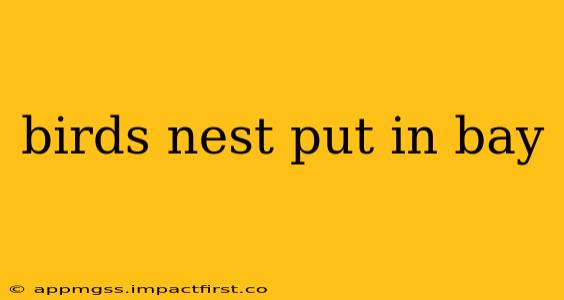Put-in-Bay, a charming island in Lake Erie's western basin, offers more than just stunning sunsets and vibrant nightlife. It's also a haven for a diverse array of bird species, making it a paradise for birdwatchers and nature enthusiasts. This guide delves into the avian life found on Put-in-Bay, exploring where to spot them, what types of nests you might encounter, and how to contribute to their conservation.
What kinds of birds can I see in Put-in-Bay?
Put-in-Bay's diverse habitats – from the open waters of Lake Erie to the wooded areas of South Bass Island – support a rich variety of birdlife. Common sightings include various species of waterfowl like ducks, geese, and swans, particularly during migration seasons. Songbirds are abundant in the island's forests and shrublands, with species like warblers, vireos, and flycatchers frequently observed. Raptors such as hawks and ospreys can also be seen soaring overhead, hunting for fish and small mammals. Specific species will vary depending on the season. Spring and fall migrations bring particularly impressive displays of diverse bird species. Consulting local birding guides or joining guided birdwatching tours can significantly enhance your spotting opportunities.
Where are the best places to birdwatch on Put-in-Bay?
The best birdwatching locations on Put-in-Bay depend largely on the species you're hoping to see. For waterfowl, the shores of Lake Erie provide excellent viewing opportunities, especially near Perry's Victory and International Peace Memorial. The wooded areas of the island, including the state park and less developed areas, are ideal for spotting songbirds and smaller avian species. Consider visiting the Put-in-Bay Township Park for a chance to see a wider variety of species. Remember to bring binoculars for a closer look! Quiet observation is key to successful birdwatching; avoid making loud noises or sudden movements that might scare the birds away.
What types of bird nests can I find on Put-in-Bay?
The types of bird nests found on Put-in-Bay are as varied as the species themselves. Waterfowl often build nests near the water's edge, sometimes using vegetation or creating depressions in the ground. Songbirds construct more intricate nests, often utilizing twigs, leaves, grasses, and other natural materials high in trees or shrubs. Raptors may build large nests in tall trees, utilizing branches and other sturdy materials. It's crucial to remember that disturbing bird nests is illegal and harmful to the birds and their young. Observe nests from a distance and appreciate their natural beauty without interfering.
Are there any specific bird nests I should look out for?
While specific nest locations aren't publicly shared to protect the birds, focusing on areas with dense vegetation or near water sources will increase your chances of spotting nests. Remember responsible birdwatching practices: observe nests from afar with binoculars, and never disturb or approach them.
How can I help protect birds and their nests on Put-in-Bay?
Protecting the birds and their nests on Put-in-Bay requires collective responsibility. Maintain a respectful distance from nests and birds. Avoid disturbing natural habitats, and dispose of litter properly. Support organizations dedicated to bird conservation and habitat preservation. Educating yourself and others about responsible birdwatching practices is crucial for ensuring the continued health of Put-in-Bay's avian population for years to come. By being mindful of our actions, we can contribute to the preservation of this vital aspect of the island's natural beauty.
What time of year is best for birdwatching in Put-in-Bay?
Migration seasons—spring and fall—generally offer the most diverse birdwatching opportunities in Put-in-Bay. During these times, a wide range of migratory birds pass through the area, significantly expanding the variety of species visible. However, summer and winter also offer unique sightings, with resident birds showing different behaviors and plumage.
This guide provides a starting point for exploring the fascinating world of birds on Put-in-Bay. Remember responsible and respectful birdwatching is key to ensuring the preservation of these beautiful creatures and their habitats for generations to come.
